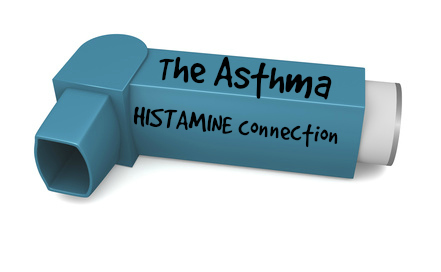
Just a few days ago I re-shared a post that garnered over 2,000 Facebook likes. I was totally shocked, as was mast cell/histamine researcher Dr. Theoharides, whom I spoke with right after re-posting.
“I’m really surprised that people didn’t realise that eczema was related to histamine/mast cells,” he told me in response.
And that got me to thinking that I really need to share more information on conditions related to histamine/mast cells.
An obvious one, at least to me, is asthma. But again, I was recently truly surprised when a group of folks online didn’t know of the connection. So here it is…
A paper published in the Canadian Society of Allergy and Clinical Immunology [1] points out that that mast cells are a primary players in asthma, while another published in 1987 [2] shares that there’s evidence that “mast cells and mast cell-derived mediators play a role in allergic and non-allergic asthma…” saying that their role is clear in allergic, nocturnal and exercise-induced asthma.
What does this mean?
So, mast cells are a vital part of the immune system. These white blood cells house histamine (the stuff that causes allergies), as well as other inflammatory molecules, that are either also housed in the mast cells, or created (synthesised), when mast cells break open, as needed.
Why on earth do we need inflammation?!
We need inflammation to protect us from bacteria/viruses (pathogens), damaged cells or irritants [3]. Inflammation also plays an important role in ovulation. Problems begin when the inflammation doesn’t subside as it’s supposed to. Maybe the body is generally out of whack, or we have too many or unstable mast cells, in some cases stress hormones (and others) can cause mast cells to go completely berserk and dump all this inflammation into the body. The fact that you’re reading my blog means that you’re probably most interested in histamine-induced inflammation and how diet can possibly control/mediate its effect on the body. You’ll find the information you’re looking for in the

Another research article I found points out that IgE mediated activation of mast cells and basophils underlies asthma [4]. This means that in some people, allergies can activate asthma. The specific driving force behind this is histamine, but they’re not really sure why. Interestingly, researchers initially failed to link histamine to asthma, but now, with the (relatively) newly discovered histamine receptor 4 (H4), they’ve reassessed [5]. But as we said before, histamine is only one of the molecules release from mast cells – leukotrines, prostaglandin D2 and others, contribute to asthma [6].
The question I’d love answered: is asthma a separate condition requiring a different diagnosis, or can we just include it under the umbrella of mast cell-histamine disorders like histamine intolerance, mast cell activation or mastocytosis? This might seem to be an irrelevant question to some, but honestly, when I meet people who have over 20 separate diagnoses, and are taking meds for each one, with no regard for which ones overlap, thanks mainly to seeing the relevant specialist for each one, I want to cry. And I often do.
How can a person function? How can they feel there’s any hope that they will recover one day, under the weight of all this?
For some, taking control of the situation can offer some measure of relief. I’m not saying don’t work with doctors or take meds, I’m saying there’s a holistic option that’s as accessible to you as opening up your fridge, as an adjunct to whatever other avenue you’re pursuing.
Where to start
Asthma in particular has been shown to respond to pranayama meditative breathing, with a number of studies showing that it considerably decreases histamine induced asthma symptoms (compared to placebo groups). The yogic breathing groups were able to cut back on their steroid inhalers and also required a higher dose of histamine to induce an attack [7].
Yoga meanwhile is great for lowering inflammation – specifically interleukins [8], which have been shown to induce allergic asthma [9].
Thought I’d forgot diet? Not a chance! Prostaglandin d2 and other inflammatory molecules involved in asthma and histamine disorders generally can be inhibited by a number of foods: cucumber, red ginger (glangal), mangosteen [all 10], custard apple and coriander [11], while curry has been shown to be as effective as a standard asthma bronchodilator [12].
Stabilising mast cells so they don’t release histamine and other inflammation in the first place is always a great approach. Quercetin, luteolin and rutin, bioflavonoids found in foods like blueberries, broccoli, kale, and most brightly coloured foods, have been shown to prevent mast cells from leaking unnecessarily, even more effectively than the most commonly prescribed pharmaceutical (sodium cromlyglycate) [13]. Some doctors might argue that it’s impossible to work your way up to a therapeutic dose at the dinner table, so some of us take a quercetin/luteolin supplement to help out .
Please don’t forget antihistamine, pain killing foods can still hurt us, so please always check with your doctor before adding new foods to your diet.
——-REFERENCES——-
[1] http://www.aacijournal.com/content/4/2/84
[2] http://journal.publications.chestnet.org/article.aspx?articleid=1060302
[3] http://en.wikipedia.org/wiki/Inflammation
[4] http://www.jci.org/articles/view/59072
[5] http://link.springer.com/chapter/10.1007%2F978-1-4419-8056-4_6
[6] http://erj.ersjournals.com/content/29/5/827.full
[7] https://healinghistamine.com/yogic-pranayama-breathing-lowers-histamine/
[8] http://www.ncbi.nlm.nih.gov/pubmed/15546393
[9] https://healinghistamine.com/fight-histamine-induced-inflammation-yoga/
[10] http://www.ncbi.nlm.nih.gov/pmc/articles/PMC2885094/
[11] http://www.ajebs.com/vol1/22.pdf
[12] http://www.jcimjournal.com/articles/publishArticles/pdf/201181127102.pdf
[13] http://www.plosone.org/article/info%3Adoi%2F10.1371%2Fjournal.pone.0033805













